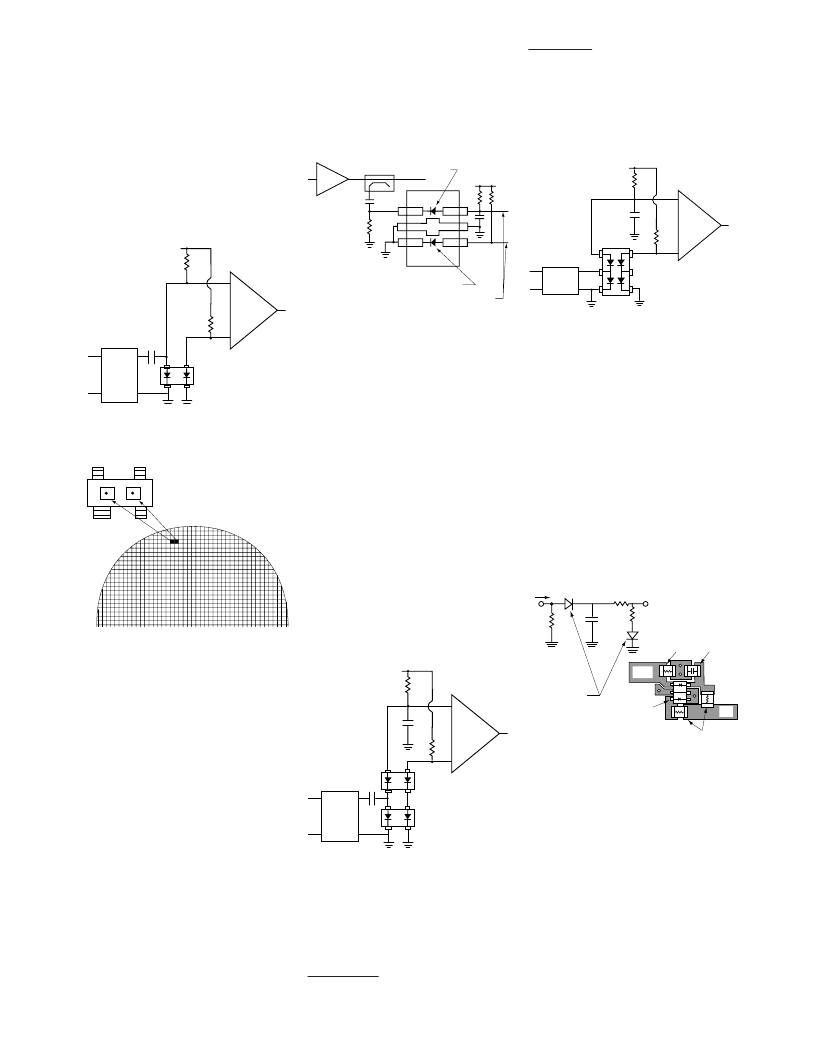- 您現(xiàn)在的位置:買賣IC網(wǎng) > PDF目錄370699 > HSMS-282N Surface Mount RF Schottky Barrier Diodes(表貼型射頻肖特基勢壘二極管) PDF資料下載
參數(shù)資料
| 型號: | HSMS-282N |
| 英文描述: | Surface Mount RF Schottky Barrier Diodes(表貼型射頻肖特基勢壘二極管) |
| 中文描述: | 表面貼裝射頻肖特基二極管(表貼型射頻肖特基勢壘二極管) |
| 文件頁數(shù): | 7/12頁 |
| 文件大小: | 141K |
| 代理商: | HSMS-282N |

7
assures that the characteristics of
the two diodes are more highly
matched than would be possible
through individual testing and
hand matching.
matching
network
differential
amplifier
HSMS-2825
bias
Figure 13. Differential Detector.
Figure 14. Fabrication of Agilent
Diode Pairs.
In high power applications,
coupling of RF energy from the
detector diode to the reference
diode can introduce error in the
differential detector. The
HSMS-282K diode pair, in the six
lead SOT-363 package, has a
copper bar between the diodes
that adds 10 dB of additional
isolation between them. As this
part is manufactured in the
SOT-363 package it also provides
the benefit of being 40% smaller
than larger SOT-143 devices. The
HSMS-282K is illustrated in
Figure 15—note that the ground
connections must be made as
close to the package as possible
to minimize stray inductance to
ground.
PA
detector diode
reference diode
to differential amplifier
V
bias
HSMS-282K
Figure 15. High Power Differential
Detector.
The concept of the voltage
doubler can be applied to the
differential detector, permitting
twice the output voltage for a
given input power (as well as
improving input impedance and
suppressing second harmonics).
However, care must be taken to
assure that the two reference
diodes closely match the two
detector diodes. One possible
configuration is given in Fig-
ure 16, using two HSMS-2825.
Board space can be saved
through the use of the HSMS-282P
open bridge quad, as shown in
Figure 17.
matching
network
differential
amplifier
HSMS-2825
HSMS-2825
bias
Figure 16. Voltage Doubler
Differential Detector.
differential
amplifier
HSMS-282P
bias
matching
network
Figure 17. Voltage Doubler
Differential Detector.
While the differential detector
works well over temperature,
another design approach
[3]
works
well for large signal detectors.
See Figure 18 for the schematic
and a physical layout of the
circuit. In this design, the two
4.7 K
resistors and diode D2 act
as a variable power divider,
assuring constant output voltage
over temperature and improving
output linearity.
RF
in
V
o
D1
33 pF
HSMS-2825
or
HSMS-282K
HSMS-282K
4.7 K
33 pF
4.7 K
4.7 K
D2
68
68
RF
in
V
o
Figure 18. Temperature Compensated
Detector.
In certain applications, such as a
dual-band cellphone handset
operating at both 900 and
1800 MHz, the second harmonics
generated in the power control
output detector when the handset
is working at 900 MHz can cause
problems. A filter at the output
can reduce unwanted emissions
at 1800 MHz in this case, but a
[3]
Hans Eriksson and Raymond W. Waugh, “A Temperature Compensated Linear Diode
Detector,” to be published.
相關(guān)PDF資料 |
PDF描述 |
|---|---|
| HSMS-282P | Surface Mount RF Schottky Barrier Diodes(表貼型射頻肖特基勢壘二極管) |
| HSMS-282R | Surface Mount RF Schottky Barrier Diodes(表貼型射頻肖特基勢壘二極管) |
| HSMS-285A | Surface Mount Microwave Schottky Detector Diodes in SOT-323(表貼型微波肖特基檢測二極管(SOT-323封裝)) |
| HSMS-286A | Surface Mount Microwave Schottky Detector Diodes in SOT-323(表貼型微波肖特基檢測二極管(SOT-323封裝)) |
| HSMS-286K | Surface Mount RF Schottky Detector Diodes in SOT-363(表貼型射頻肖特基檢測二極管(SOT-363封裝)) |
相關(guān)代理商/技術(shù)參數(shù) |
參數(shù)描述 |
|---|---|
| HSMS-282N-BLK | 制造商:AGILENT 制造商全稱:AGILENT 功能描述:Surface Mount RF Schottky Barrier Diodes |
| HSMS282N-BLK | 制造商:未知廠家 制造商全稱:未知廠家 功能描述:COMMON ANODE DIODE ARRAY|TSOP |
| HSMS-282N-BLKG | 功能描述:肖特基二極管與整流器 15 VBR 1 pF RoHS:否 制造商:Skyworks Solutions, Inc. 產(chǎn)品:Schottky Diodes 峰值反向電壓:2 V 正向連續(xù)電流:50 mA 最大浪涌電流: 配置:Crossover Quad 恢復(fù)時間: 正向電壓下降:370 mV 最大反向漏泄電流: 最大功率耗散:75 mW 工作溫度范圍:- 65 C to + 150 C 安裝風(fēng)格:SMD/SMT 封裝 / 箱體:SOT-143 封裝:Reel |
| HSMS-282N-TR1 | 制造商:AGILENT 制造商全稱:AGILENT 功能描述:Surface Mount RF Schottky Barrier Diodes |
| HSMS282N-TR1 | 制造商:未知廠家 制造商全稱:未知廠家 功能描述:COMMON ANODE DIODE ARRAY|TSOP |
發(fā)布緊急采購,3分鐘左右您將得到回復(fù)。